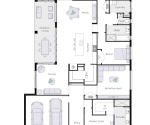Net-Zero vs. Off-the-Grid Homes: What’s the Difference?
With the rise of sustainable living, many people are exploring ways to reduce their environmental impact and lower their energy bills. Two common approaches are net-zero homes and off-the-grid homes—but are they the same thing? Not quite! While they share similarities, key differences set them apart. Let’s break it down.
What Is a Net-Zero Home?
A net-zero home is designed to produce as much energy as it consumes over the course of a year. These homes are typically connected to the electrical grid but rely on energy-efficient design and renewable energy sources to balance their usage.
Key Features of a Net-Zero Home:
✔ High Insulation & Airtight Construction – Reduces energy loss and maintains indoor temperature efficiently.
✔ Energy-Efficient Windows & Doors – Prevents drafts and enhances thermal performance.
✔ Renewable Energy Sources (Solar, Wind, Batteries) – Generates electricity to offset usage.
✔ Efficient Heating & Cooling (Heat Pumps, Passive Design) – Minimises energy consumption.
✔ Water Conservation & Sustainable Materials – Uses rainwater collection, greywater recycling, and eco-friendly materials.
What Is an Off-the-Grid Home?
An off-the-grid home is completely disconnected from public utilities, meaning it generates and stores all its own energy, water, and waste management. These homes require self-sufficiency in all areas, not just energy.
Key Features of an Off-the-Grid Home:
✔ Independent Power Generation (Solar, Wind, Hydro) – No reliance on the electrical grid.
✔ Battery Storage & Backup Systems – Stores excess power for nighttime or cloudy days.
✔ Water Collection & Filtration – Rainwater harvesting, well water, or desalination systems.
✔ Composting Toilets & Septic Systems – Handles waste without public sewage.
✔ Backup Generators (Optional) – Provides extra power when renewable sources are insufficient.
Is an Off-the-Grid Home Automatically Net Zero?
Not necessarily! While an off-grid home produces its own energy, it doesn’t always achieve net-zero energy consumption.
💡 A net-zero home balances energy production and use, often with the help of grid connectivity to send or receive energy when needed. 💡 An off-grid home must rely entirely on its own power sources. If it uses a generator or burns fuel for backup power, it may not be truly net zero.
Which One Is Right for You?
Choosing between a net-zero and an off-the-grid home depends on your lifestyle, location, and sustainability goals.
- If you want lower energy bills and grid support when needed, a net-zero home is a great option.
- If you want total self-sufficiency and freedom from public utilities, an off-the-grid home is the way to go.
With the growing interest in sustainable housing, many prefab and eco-friendly home builders (like the ones I work with!) are incorporating net-zero principles into their designs. Whether you’re looking for energy efficiency or complete independence, there are plenty of ways to build a home that aligns with your values.










